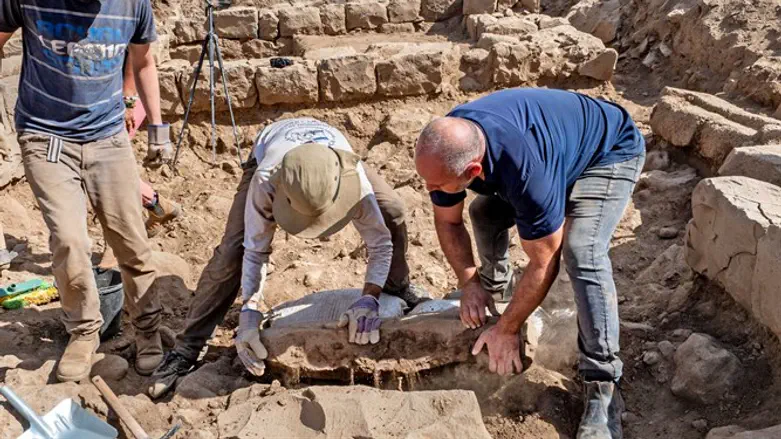
The "Nafah army base" recently made headlines in the famous Israeli TV series on the 1973 Yom Kippur War, Valley of Tears (Hebrew: Sh‘at Ne‘ila) on Channel Kan 11; but, an archaeological excavation conducted on the Golan Heights last month revealed for the first time that the name "Nafah" was given to the site as early as 1,700 years ago.
The boundary stone was discovered during an archaeological excavation conducted by the Israel Antiquities Authority when the Mekorot Water Company was about to install a water pipeline at Nafah.
This is within the framework of the projects that the company is carrying out for laying water lines in the Golan Heights, with a total length of 20 kilometers.
The water pipeline of Nafah-Kedmat Zvi will serve as the main water line in the water supply system to IDF bases in the Golan Heights and the town of Katzrin.
At the site of the excavation, directed by Dina Avshalom-Gorni and Yardenna Alexandre of the Israel Antiquities Authority, with the participation of pre-military academy (mechinot) students from Maayan Baruch and Kela Alon, as well as volunteers from the community, a boundary stone inscribed in Greek was unexpectedly uncovered.
The stone was uncovered in secondary use to cover a tomb.
The decipherment of the inscription by Israel Antiquities Authority, Dr. Danny Syon, together with Prof. Haim Ben-David from the Kinneret Academic College, aroused great excitement.According to researchers, "The inscription, which mentions the name "Kfar Nafah," (Nafah village) was inscribed on a boundary stone."
"Under the reign of the Roman Emperor Diocletian (around 300 CE), these stones were placed as the boundaries of villages, for the purpose of collecting taxes. This is the first boundary stone in the center of the Golan Heights, on which appears the name of a place that has been preserved to this day; Nafah was the name of the Syrian village that existed here until the Six Day War in 1967, and now Nafah is the adjacent military base."

Researchers add that "Usually, ancient names are preserved as a result of settlement continuity which preserves ancient names from generation to generation. However, at Nafah the ancient remains have not revealed such settlement continuity, and since the Byzantine period - about 1500 years ago – and up to modern times, settlements are not known here, apart from briefly during the Mamluk period (13th -15th centuries CE). For this reason, the preservation of the name is intriguing and astonishing. The discovery of the boundary stone inscribed with the name of a settlement has been preserved to this day, is a rare occurrence."
"The stone reinforces the possibility that names of ancient settlements were preserved for many generations, even where settlement continuity did not take place."
According Yardenna Alexandre and Dina Avshalom-Gorni of the Israel Antiquities Authority: "The fascinating excavation at Nafah uncovered a public building from the Mamluk period, which served as a road station."
"This is the first public administrative building from the Mamluk period excavated in the Golan Heights. The road station was built on the main road connecting the Galilee to Damascus, and probably served as a stopover and resting place for traders and government officials travelling from Safed, the capital city of Mamluk Galilee, to Damascus. Here they dined and slept, reorganized their equipment for the journey, and cared for the horses.
In the building’s courtyard, the remains of a furnace and some iron slag were found, indicating that an ironsmith may have worked here, repairing the horseshoes during the stopover."
Eyal Ben David, Unit Manager of Project Management at Mekorot, "As a company that devotes a lot of resources to building new water infrastructure throughout Israel, to strengthening the stability of the water economy also in the future, we are happy for the opportunity we have to contribute to the preservation of the heritage of the past. The company is proud to be part of the important discovery that was revealed when laying the Nafah-Kedmat Zvi water pipeline, which will serve as the main water line in the water supply system for IDF bases in the Golan Heights and the town of Katzrin. This is one of the many projects that Mekorot is promoting in the Golan Heights area."